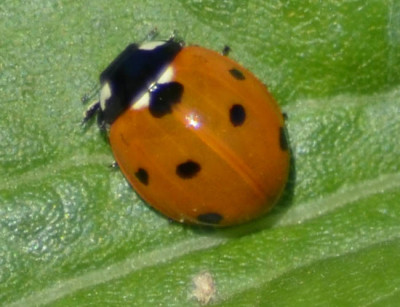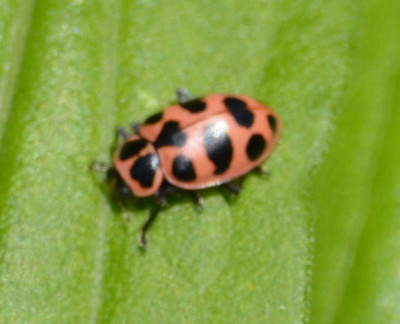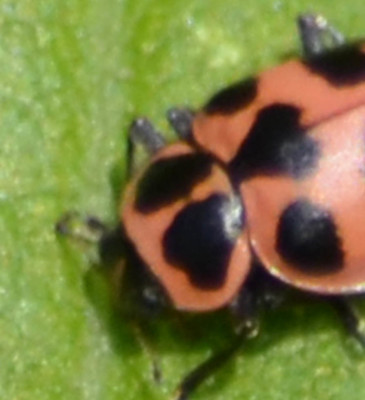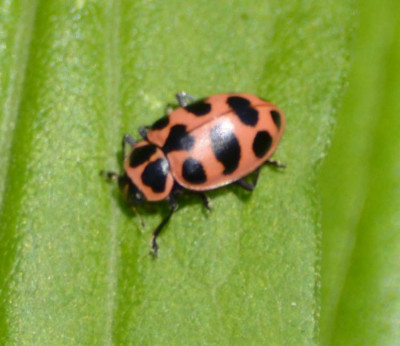In mid-July I visited Lakeside Park in Mississauga. The uncut area has grown into a virtually impenetrable tangle of thistles, burdock and goldenrod. Feeling lazy (and a bit nervous of ticks) I stayed on the edge of the jungle on the grass mowed as short as a new recruit’s hair.
Dragonflies were performing an air show overhead and butterflies were fighting and loving in their haphazard erratic way. A bright glittering metallic insect caught my eye and from there my glance landed on the first ladybug. When I looked closer I realized the plants were aswarm with patrolling ladies. Most were your typical red ladybugs with black spots: all except one. This exception was pink! It was a flattened oval shape and it had an obvious two-part body. What kind was it?
Everyday Ladybugs
This is a Seven Spot Ladybeetle, Coccinella septempunctata.
Most of the ladybugs I’ve met in my garden are round. They are usually red or orange with black spots. Their faces are so tucked back against the “shell” formed from their wing cases that they appear not to have a head at all. Last fall, I did find one ladybug that was black with two red dots but even it fit the traditional shape.
This ladybeetle was new to me. It was decidedly oval reminding me of a watermelon seed. And although the photos don’t do it justice it looked quite pink not light red or orange.
Unfortunately just as I was trying to get a good focus on it, the bug flew.
I later read that this type of ladybug is very active. Hopefully it found a good patch of insect eggs or aphids to snack on. If not, there were many coneflowers in bloom as well as other less showy wildflowers. Since this ladybug eats pollen as a major part of its diet, it should thrive at Lakeside.
What Kind of Ladybug is Pink and Oval?
Fortunately very few ladybugs are pink and even fewer of those are oval. There doesn’t seem to be much doubt that this was a Coleomegilla maculata. That’s a Spotted Ladybeetle when it’s just having a few friends over for sips of dew. To be exact, it seems to have been a Coleomegilla maculata lengi, or Pink Spotted Ladybeetle.
Does anyone but me think the word “spotted” is unnecessary? How many ladybeetles are there that are NOT spotted? At least in the subspecies’s common name they included the useful word “pink.”
Ladybeetle, of course, is just the fancy European name for a Ladybug.
I had thought perhaps it should be called the Pink Heart Ladybug as my foundling had a lovely heart-shaped spot just behind the “head.” Unfortunately, when I looked at other photos of this creature I found that the shape of that spot is variable and it’s not always heart-shaped. So I guess I was just lucky to find a romantic beetle.
Is That Second Part at the Front Really the Head?
Unlike most of the ladybugs I’ve seen, this one came with two obvious parts. There was a small part at the front end and then a larger oval body. The part near the front had two large spots on it.
It wasn’t the head, though. The head was a much smaller part in front of that, which is not clearly visible in my photos. That front end section is called the pronotum.
Is this Pink Spotted Ladybeetle a Stranger Here?
Many of the common ladybugs seen in Ontario are not native to Canada. They were introduced by gardeners and farmers to help control pests such as aphids and exploded out into the wild displacing their native relatives. The Multicoloured Asian Ladybug is perhaps the most common bug around now.
Somewhat to my surprise, I found that the Pink Spotted is native to Canada.
Farmers are happy to have it around as it likes to eat the eggs of corn borers that attack corn grown for human consumption.
I’m glad I discovered this ladybug. Now I just have to figure out what kind the other 100 ladybeetles were!
Related Reading
- Species Coleomegilla maculata – Spotted Lady Beetle This article has photos, a distribution map, and food, life cycle, and identification information.
- Identifying the Four Most Common Ladybugs
- What Mississauga Ladybug is Black With 2 Red Spots?
Join In
Have you seen any Pink Ladybugs? Have you ever discovered their larval stage, which look a bit like tiny lobsters chasing aphids around your daisy’s leaves? Please share your experiences with a comment.





this is an asian ladybug, a nasty bugger.
The Seven-spotted arrived here from Europe but the pink Spotted Ladybeetle is actually one of our natives. You’re right that the multi-coloured Asian Ladybeetles are far more common and come with a large variety in their number of spots. There’s one at https://naturalcrooks.com/rambles/monarchs-launch-over-lake-ontario/ near the end of the article.